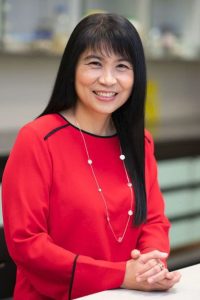Why Singapore’s English Teachers Should Embrace Singlish, Not Fight It
Is it time for Singaporean educators to embrace Singlish as a legitimate learning tool? What the Research […]
Read More
Science, Technology, Engineering and Mathematics (STEM) education, an interdisciplinary approach to learning and teaching, plays a critical role in fostering 21st century skills such as critical thinking, collaboration, communication and creativity. How can teachers sharpen their tools and widen their strategies in teaching STEM subjects more efficiently in the classroom? SingTeach talks to an associate professor from NIE, Tan Aik Ling, on her latest research study that compares students’ learning experiences when engaging in problem-centric and solution-centric STEM activities.
According to the U.S. Bureau of Labor Statistics, there were 8.6 million science, technology, engineering and mathematics (STEM) jobs in the country in 2015 (U.S. Bureau of Labor Statistics, 2017). STEM employment is also predicted to rise in the United States by about 13% between 2012 and 2022 (U.S. Bureau of Labor Statistics, 2014). In Singapore, the demand for STEM graduates is expected to grow.
“A similar trend will also likely be seen in Singapore,” says Associate Professor Tan Aik Ling, who is also one of the founding members of meriSTEM@NIE, a STEM education research centre in NIE. “It is a given that the jobs of the future will be integrally STEM driven. Hence, it is important to not only provide, but also improve STEM education.”
 Closing the Gap in STEM Education
Closing the Gap in STEM EducationCurrent integrated STEM education, however, remains fragmented. Aik Ling points out that there are gaps in the areas of designing and teaching of STEM education programmes. She emphasizes the need for an evidence-informed approach to address the problem.
“My research study aims to close the knowledge gaps in this area. One of its main objectives is to collect data on the different experiences that each student faces as they engage with integrated STEM activities in the classroom. We focus on three key aspects: questioning, argumentation and creative thinking,” she explains.
Involving lower secondary classes from three secondary schools, Aik Ling adds that the activities are carried out under specific conditions.
“Each school will have one class experiencing the curriculum starting with a problem (problem-centric) and another class which will be experiencing the curriculum starting with a solution (solution-centric).”
The problem-centric classroom will have students studying and solving a problem, for example, traffic congestion at a junction while the solution-centric classroom will begin with a solution, for example, an intelligent traffic light. Both of these teaching approaches go beyond the memorization of content and place students at the centre of the learning process.
So how does applying these inquiry-based learning approaches help equip students with 21st century competencies?
Aik Ling shares some preliminary observations: “The two different approaches – problem-centric and solution-centric – show that the learning experiences of students, in terms of their questioning, argumentation and creative thinking, would be different.”
“A problem-centric integrated STEM activity will afford more divergent learning experiences for students as there could be multiple solutions suggested for a specific problem. The array of possible solutions offered will enable the development of skills such as critical evaluation and negotiation.”
In comparison, a solution-centric integrated STEM activity, in which the students deconstruct the solution, provides limited opportunities for students to generate alternative ideas, critique and negotiate ideas. The learning outcomes, however, will be more focused and specific, and will likely lead to better conceptual learning.
“The data gathered at this stage on the different learning experiences and outcomes of the students give us an indication of how teachers should prepare when planning STEM activities in the classroom,” Aik Ling says.
For example, when carrying out a problem-centric integrated STEM activity, teachers will need to be versatile and prepared to handle novel and unexpected solutions. In contrast, when facilitating a solution-centric STEM activity, teachers will have the benefit of being able to accurately map the learning outcomes.
Educators are encouraged to keep all of these factors in mind when designing integrated STEM activities. “Using what we have observed in the classroom, we are also generating the key features that define a STEM classroom so as to further facilitate teachers’ planning and reflection,” adds Aik Ling.
“The two different approaches – problem centric and solution centric – show that the learning experiences of students, in terms of their questioning, argumentation and creative thinking, would be different.”
– Aik Ling shares some preliminary observations
“When given the room and opportunity, we find that the students are extremely divergent and enjoy generating creative solutions to the problems presented,” she shares.
Even though teachers find it challenging to set aside time within the curriculum for STEM programmes, they are focusing on the positives. “Teachers are excited about being involved with STEM activities as they see value in exposing their students to complex, persistent and extended problem-solving,” she adds.
The positive feedback has been encouraging but Aik Ling admits that more can be done for STEM education in Singapore. In line with meriSTEM@NIE’s future plans, Aik Ling’s project is a stepping stone to nurturing, developing and refining STEM learning and teaching in Singapore and beyond.
“In the short term, meriSTEM@NIE hopes to generate sufficient research evidence to inform integrated STEM education in Singapore and in Asia. In the long term, we hope to develop the organization into a ‘go-to’ centre for integrated STEM education internationally,” she says.
References
U.S. Bureau of Labor Statistics. (2014). STEM 101: Intro to tomorrow’s jobs. Retrieved from https://www.bls.gov/careeroutlook/2014/spring/art01.pdf
U.S. Bureau of Labor Statistics. (2017). STEM Occupations: Past, Present, And Future. Retrieved from https://www.bls.gov/spotlight/2017/science-technology-engineering-and-mathematics-stem-occupations-past-present-and-future/pdf/science-technology-engineering-and-mathematics-stem-occupations-past-present-and-future.pdf